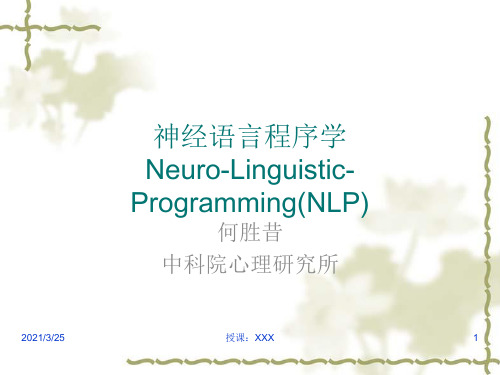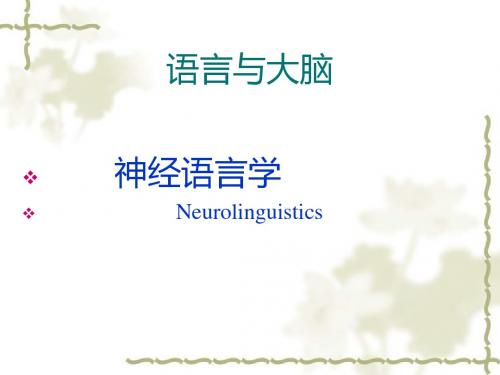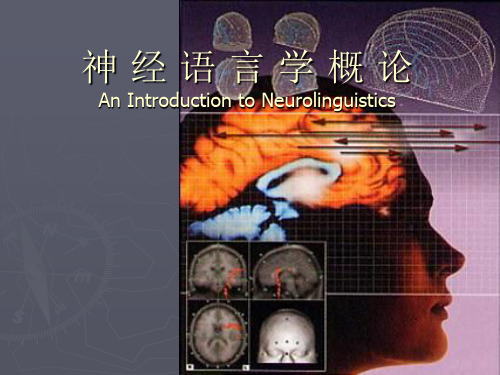神经语言学和心理语言学 (课堂PPT)
合集下载
神经语言程序学PPT课件

❖ 4.变速
❖ 5.变形
❖ 6.变声
7.测试 2❖021/3/25
授课:XXX
8
积极行为技术-宰杀大象法
❖
心理除法——将艰巨的任务分
解为小目标,锁住每一个小目标,
坚定地一步一步的走下去。
2021/3/25
授课:XXX
9
积极行为技术-懒人启动法
❖ 你只要能学会懒惰,就可以学会勤奋。 ❖ 在开始时,接受自己用一种缓慢而懒惰的方
神经语言程序学
Neuro-LinguisticProgramming(NLP)
何胜昔
中科院心理研究所
2021/3/25
授课:XXX
1
NLP的概念
身心语言程序学(Richard Bandler and John Grinder)
❖ 我们通过语言来影响自己与他人的身 心,同样,他人也通过语言来影响我
们,这个相互影响的过程就是身心语 言程序,即NLP。
❖ NLP研究的就是我们的语言对身心所 起作用的程序。
❖ 拥有不同的程序,就使我们拥有不同
的人生。 2021/3/25
授课:XXX
2
积极主动的心态调节
❖ 人生最大的限制来自于内心。 ❖ 我们内心的信念决定了我们外在的结果。 ❖ 人与人之间的心态差异很细小,但是人与人
之间的成就差别很巨大。
2021/3/25
2021/3/25
授课:XXX
24
透视未来的宏远目光
❖ 掌握大的趋势 ❖ 寻找大的市场 ❖ 从竞争对手少的地方入手 ❖ 敏锐的观察,不断地思考
2021/3/25
授课:XXX
25
影响力的本质
❖ 双向双赢的人脉建设
❖ 我们不能做大事,只能用大爱做小事
语言学概论(完整版)ppt课件

根据语言的形态、句法 、语义等特征,将语言 分为不同的类型,如孤 立语、粘着语、屈折语 等。
跨语言比较
通过对不同类型语言之 间的比较,揭示语言之 间的共性和差异,以及 语言类型与文化、社会 等因素的关系。
类型学视角
从类型学的角度出发, 分析语言的结构和功能 ,探讨语言的本质和演 变规律。
语言起源和演变过程探讨
语音、词汇、语法三要素
01
02
03
语音
语音是语言的声音形式, 包括音素、音节、声调等 要素,具有区别意义的作 用。
词汇
词汇是语言的建筑材料, 包括词和固定短语,体现 语言的文化特色和时代特 征。
语法
语法是语言的组织规则, 包括词法、句法等,使语 言具有生成和理解的能力 。
语言与社会文化关系
语言与社会
语音实验方法
通过仪器分析和实验验证,探究语 音的生理、物理和心理特性。
发音器官与发音过程分析
发音器官
01
包括呼吸器官、喉头、声带、口腔、鼻腔等,以及它们的结构
和功能。
发音过程
02
分析发音时气流的通道、声带的振动、口腔和鼻腔的共鸣等作
用,揭示语音产生的机制。
发音差异与语音变化
03
探讨不同发音器官和发音过程对语音的影响,以及语音在历史
语音学定义
研究人类语言声音的科学,包括语音 的产生、传播、感知和变化等方面。
语音四要素
音质、音高、音强和音长,它们在语 音中的表现和作用。
语音单位
音素、音节、音步等,以及它们之间 的关系和组合规律。
音系学理论与方法
音系学定义
研究语言声音系统的科学,探讨 语音单位的分类、组合和变化规
则。
音位理论
跨语言比较
通过对不同类型语言之 间的比较,揭示语言之 间的共性和差异,以及 语言类型与文化、社会 等因素的关系。
类型学视角
从类型学的角度出发, 分析语言的结构和功能 ,探讨语言的本质和演 变规律。
语言起源和演变过程探讨
语音、词汇、语法三要素
01
02
03
语音
语音是语言的声音形式, 包括音素、音节、声调等 要素,具有区别意义的作 用。
词汇
词汇是语言的建筑材料, 包括词和固定短语,体现 语言的文化特色和时代特 征。
语法
语法是语言的组织规则, 包括词法、句法等,使语 言具有生成和理解的能力 。
语言与社会文化关系
语言与社会
语音实验方法
通过仪器分析和实验验证,探究语 音的生理、物理和心理特性。
发音器官与发音过程分析
发音器官
01
包括呼吸器官、喉头、声带、口腔、鼻腔等,以及它们的结构
和功能。
发音过程
02
分析发音时气流的通道、声带的振动、口腔和鼻腔的共鸣等作
用,揭示语音产生的机制。
发音差异与语音变化
03
探讨不同发音器官和发音过程对语音的影响,以及语音在历史
语音学定义
研究人类语言声音的科学,包括语音 的产生、传播、感知和变化等方面。
语音四要素
音质、音高、音强和音长,它们在语 音中的表现和作用。
语音单位
音素、音节、音步等,以及它们之间 的关系和组合规律。
音系学理论与方法
音系学定义
研究语言声音系统的科学,探讨 语音单位的分类、组合和变化规
则。
音位理论
心理语言学-PPT课件

聋孩案例说明,就是在恶劣的环境里,儿童都有某种自然倾向 和能力去发展一种自成体系的交际系统。这种“应付”能力使 人们得出这样的结论:就是在语言没有准备的条件下,人类都 准备学习语言。这种语言能力应该就是人类的一种属性,是人 类演化的一大成果:但要把这种能力发挥出来必须具有一定的 条件,那就是人类社会。 B、教黑猩猩学人类语言 案例1、花6年时间才教会一个小黑猩猩发出4个像英语的声音。 说明猿类的发音器官没有说人类语言的生物基础。 案例2(多案例组合)、教黑猩猩学美国手势语。结果—— 1)黑 猩猩都能习得符号(signs);2)黑猩猩还有组合符号的能力;3) 黑猩猩有教同伴或后代学美国手势语的趋势(可能)。
三、大脑与语言
1、语言中枢 布罗卡区(Broca’s Area):法国人Broca,1863年正式宣布他 的发现——一个大脑第3左额回受到损害的病人丧失了说话能 力,因此大脑的这个区域应该是语言中枢。 这个区域后称布罗 卡区,而这种病也就称为布罗卡失语症(Broca‘s Aphasia )。 布罗卡区位于主侧大脑半球额下后部靠近岛盖处,即布鲁德曼 第 44、45 区。布罗卡氏区损害导致运动性失语症,由于有关 肌肉共济失调,不能将语言以口语方式表达出来。障碍程度轻 重不等。轻者找到个合适的词,重复使用有限的词汇,句子简 单,语法单调,表达中有较长的停顿。重者言语功能丧失,能 发音,但构成不了词句。
3、语言习得的临界期 右半球具有某些低级的语言能力,在左半球出现障碍时,右 半球会否取而代之?
据观察:青春期以前的儿童似乎有一种“转换机制(switch mechanism)”,如果左半球语言中枢受损,语言中枢会 转移到右半球,不过得从头再学话。而过了青春期后,语言 能力就不那么容易恢复了。
案例——一个女孩12岁半以前生活在完全与语言隔绝的环境中, 被发现后才开始学话。到18岁,才慢慢学会说短句,只有最低 限度的语法能力。但用发挥右半球功能方面并不亚于正常小孩, 通过检验,两耳健全,但用右半球来处理所有听觉信息。进一 步证明大脑两半球分工,且证明13岁前,由于与语言社区隔绝, 管辖语言中枢的左脑出现功能上的萎缩,所以之后要用右脑来 执行语言和非语言两种不同的功能。 说明:大脑左半球仅仅在某一阶段以前才有习得语言的倾向。 这就是所谓的“临界期” 但临界期的说法(假设)远非定论。
《心理语言学》课件

思维对语言的影响
思维驱动语言表达
人们通过思维对事物进行认知、分析和判断, 进而形成语言表达的内容。
思维决定语言表达方式
不同的思维方式会影响人们对同一种事物的表 达方式,从而形成不同的语言风格。
思维创新语言
随着思维的发展,语言也在不断演变和创新,新的词汇、表达方式和语法结构 不断涌现。
语言与思维的相互作用
THANKS
感谢观看
03
语言与思维的关系
语言对思维的影响
语言是思维的载体
语言为人类提供了表达和交流思想的工具,使得思维 能够被记录、传递和共享。
语言塑造思维方式
语言的结构、语法和词汇会影响人们对世界的认知方 式,从而影响人们的思维方式。
语言限制思维广度
语言的有限性决定了人们思维的边界,限制了人们的 想象力和创造力。
长期记忆
长期记忆是储存和提取长期语言知识的关键,包括词汇、语法规 则、句型等。
记忆与学习
语言记忆与语言学习密切相关,良好的记忆能力有助于提高语言 学习的效果。
语言理解
词汇理解
词汇理解是对词汇意义的获取和 加工,包括对词义、词性、词组 搭配等的理解。
句子理解
句子理解是对句子意义的获取和 加工,包括对语法结构、语义关 系、语境信息的理解。
心理语言学
目录Байду номын сангаас
• 心理语言学概述 • 语言认知过程 • 语言与思维的关系 • 语言习得与发展 • 语言障碍与治疗 • 心理语言学的应用
01
心理语言学概述
定义与特点
定义
心理语言学是研究语言的心理过程的 学科,主要探讨语言与认知、情感、 动机等心理因素之间的关系。
特点
心理语言学关注语言使用中的心理过 程,包括语言的感知、记忆、理解、 产生等,强调语言与思维、认知的相 互作用。
神经语言学-PPT精选文档

神经语言学的地位: 神经语言学是语言学的当代形态,它是语言 学学术的创新。在本质上它任然是属于基础 学科。其研究的宗旨仍然是语言的本质,研 究的本体任然是语言。
方法:神经语言学可从两个角度进行研究。
一、从异常的言语表现考察病变的神经机制 (一)表达性失语症 (二)理解性失语症 (三)命名性失语症 (四)失读症 (五)失写症 (六)失算症
二、从病变的神经机制考察异常的言语表现 (一)布洛卡失语症 (二)韦尼克失语症 (三)传导性失语症 (四)混合性失语症
总结
语言与大脑
神经语言学Ne来自rolinguistics内容
大脑(神经系统的功能) 言语障碍(失语症) 神经语言学(内容、方法、问题)
(一)
大脑
中枢神经 系统分为 脑和脊髓 两部分。
中枢神经 系统对言 语的感知、 支配和调 控功能是 通过外周 神经系统 实现的。
外周神经系统由脑神经、脊神经和植物性神 经组成,植物性神经又分为交感神经和副交 感神经,脑神经共有视神经、三叉神经、面 神经、听神经、舌咽神经、迷走神经、舌下 神经等12对。 外周神经系统在中枢神经系统的支配下保证 言语肌灵活地收缩发音器官正常活动和呼吸 运动正常进行,这一切活动相结合才能使言 语功能正常发挥。
发展简史: 早在19世纪就有一些学者致力于研究言语活 动的神经机制问题。 1836年,戴克斯(M.Dax)提出言语障碍是由 大脑左半球损伤引起的。 1861年,法国布洛卡发现言语构音能力定位 于大脑左半球的额下回后部。(物质基础)
1874年,韦尼克发现听觉性言语理解障碍是由大脑 左半球颞上回后部损伤引起的。 1892年,戴杰林发现大脑左半球角回是阅读书面语 的中枢部位。 到了1926年,英国神经科学家黑德引进了语言学概 念。他对脑局部损伤导致的失语症进行语言学分析, 从而得出与脑局部损伤相应的“命名性失语症”、 “句法失语症”、“语义失语症”等。
心理学与语言学概述PPT课件

心理学流派
研究对象
构造主义心理学
意识
意动心理学
意动(感觉、判断等的心 理活动)
机能主义心理学
意识对机体适应环境的功 效和作用
行为主义
行为
完形心理学
意识和行为的完整结构和 历程
精神分析
以患者或心理变态者为对 象专门研究潜意识
儿童认知活动主要研究智
2、心理学中的语言研究 心理学和语言学的结合从心理学作为一门 独立的学科出现之日起就开始了。冯特为 心理学家树立的目标是对支配人类认知的 原则作出明确的描述,他认为,对人类语 言的研究是洞悉人类心智的最好途径。但 是在本世纪50年代以前,心理学家对语言 现象感兴趣主要是想通过语言探索思维过 程,而不是为了研究语言现象本身;对语言 现象本身的关注大多局限于语言障碍或语 言失调的治疗方法。
儿童的词语在两岁的时候有很大的发展,包括两个方面:一是习得词汇, 一是使用单个词来表达成人需要使用多个词才可以表达的意思。儿童早期 使用的语法结构并不完全符合成人语法标准,只有在进一步发展之后,才 能习得语法范畴。
在儿童语言习得的后期阶段,大概在入学前几年,他们逐渐习得词法以 及一些复杂的句法结构。儿童在习得后期的语法习得,可以分为两个阶段: 一是连接语法阶段(connective grammar);一是递归语法阶段 (recursive grammar)。在连接语法阶段,儿童话语中出现一些可以把单 词连接起来的语法标志,如连词、介词、助词等;在递归语法阶段,儿童 话语中开始出现否定句、疑问句、被动句、复杂句,其语言意识觉醒。从 连接语法到递归语法是语言习得的一个飞跃。
随着近代哲学认识论研究转向语言哲学研
3、语言学中的心理研究 在19世纪的语言学中出现了一种关于语言的生
神经语言学的方法ppt课件

Walter J.B. van Heuven, Herbert Schriefers1, Ton Dijkstra and Peter Hagoort. Language Conflict in the Bilingual Brain. Cerebral Cortex, Advance Access published April 18, 2008.
1990年前后,伦敦医院一位医生出于治疗目的,给病人头上 安放磁铁刺激,诱发运动反射,观察到病人大姆指抽搐不已。
近年已用于临床和以人为被试的科学研究。其作用原理较简 单。把一绝缘线圈放在特定部位的头皮上,当线圈中有电流通 过时,就有磁场产生,发出短磁脉冲(brief magnetic pulses), 后者无衰减地透过头皮和颅骨,进入皮质表层数厘米并产生感 应电流,从而抑制或兴奋神经细胞的活动。
.
23
MEG简介
人脑在进行认知活动时,其磁场变化是伴随其电场变化 同时产生的,从电场变化中检测出的电信号是脑电,从磁场 变化中检测出的磁信号是脑磁,记录的脑磁信号称为脑磁图 (magnetoencephalogram, MEG)。
脑磁场是很微弱的,数量级为10~1000 fT(1fT=10-15T, 是地球磁场的10-8~10-9 ,即1亿~10亿分之一,只有用高灵 敏度的超导磁强计才能探测到。这项工作,首次由 S.J.Williamson等人于1981年完成。
局部脑血流增加、氧合血红蛋白增加过剩,超过了代谢消耗氧
的需要,结果静脉中氧合血红蛋白比例增加,脱氧血红蛋白比
例减少。前者具有抗磁性,后者具有顺磁性,其比例变化会改
变MR信号。 fMRI测量的主要就是静脉中二者比例变化产生的
MR信号变化。经计算,可观察脑. 内动态变化。
1990年前后,伦敦医院一位医生出于治疗目的,给病人头上 安放磁铁刺激,诱发运动反射,观察到病人大姆指抽搐不已。
近年已用于临床和以人为被试的科学研究。其作用原理较简 单。把一绝缘线圈放在特定部位的头皮上,当线圈中有电流通 过时,就有磁场产生,发出短磁脉冲(brief magnetic pulses), 后者无衰减地透过头皮和颅骨,进入皮质表层数厘米并产生感 应电流,从而抑制或兴奋神经细胞的活动。
.
23
MEG简介
人脑在进行认知活动时,其磁场变化是伴随其电场变化 同时产生的,从电场变化中检测出的电信号是脑电,从磁场 变化中检测出的磁信号是脑磁,记录的脑磁信号称为脑磁图 (magnetoencephalogram, MEG)。
脑磁场是很微弱的,数量级为10~1000 fT(1fT=10-15T, 是地球磁场的10-8~10-9 ,即1亿~10亿分之一,只有用高灵 敏度的超导磁强计才能探测到。这项工作,首次由 S.J.Williamson等人于1981年完成。
局部脑血流增加、氧合血红蛋白增加过剩,超过了代谢消耗氧
的需要,结果静脉中氧合血红蛋白比例增加,脱氧血红蛋白比
例减少。前者具有抗磁性,后者具有顺磁性,其比例变化会改
变MR信号。 fMRI测量的主要就是静脉中二者比例变化产生的
MR信号变化。经计算,可观察脑. 内动态变化。
心理语言学PPT课件

范畴知觉
物理刺激连续变化,对应 的知觉表现出范畴性变化
材料:最小的语音范畴对 比
词汇识别ቤተ መጻሕፍቲ ባይዱ
听觉词汇识别(spoken word recognition) 视觉词汇识别(visual word recognition)
听觉词汇识别
Cohort模型(Marlsen-Wilson, 1987) 第一个阶段,对输入信息进行听觉语音分析,激活一群可供选择的单词,即初始
词群;
第二阶段,当语音信息继续,仍然符合语音输入的词的激活水平增加,而不符合 语音输入的词的激活水平下降,直到选中群中的一个词;
最后,把选中的词整合到当前语义和句法情境中。 跨通道语义启动范式
首先通过耳机给被试呈现语音信息,在耳机中语音消失的瞬间,计算机屏幕上会 出现一个刺激,要求被试对视觉刺激进行词汇判断。
语音的声学线索 音位缺少不变(invariant)的
声学线索 缺少线性排列 协同发音
几个理论
言语知觉的动觉理论(motor theory)(Liberman, 1967) 言语知觉的目标是讲话者的发音gesture,即表征在脑中的
一致的动作命令。感知言语,就是感知讲话者的意图的 gesture。 基于听觉机制的言语知觉理论 言语声音的感知与一般的听觉和知觉学习的机制相同,听者 可以从声学信号中恢复言语信息,不需要gesture知觉的中 介。
研究的焦点 对音位的恒常的声学线索的搜索 言语知觉的心理机制 言语知觉的神经机制
辅音发音部位线索
言语知觉的脑机 制
Hickok & Poeppel(2004)
一些言语知觉范式(现象) 范畴知觉 选择性适应任务 McGurk效应:听觉/pa/,视觉/ka/,知觉/ta/ Duplex知觉
《神经语言学》PPT课件

完整版ppt
32
❖ 对现代语言学的贡献:
❖ 神经语言学的研究使现代语言学建立在客观 观察和实验的基础上,使语言学这门最接近 自然科学的社会科学获得更坚实的自然科学 基础。
完整版ppt
33
❖ 神经语言学的研究成果对认识自然语言的
本质、探索言语活动的奥秘有重大的理论意 义,同时对语言教学、外语教学失语症治疗、 聋哑人语言教学、言语功能恢复、犯罪言语 特点分析、人工智能等应用领域有重大的实 践意义。
完整版ppt
14
左右脑合作
❖ 正常人的左右脑通过脑梁紧密连接在一起, 同时活动,并不是完全将功能分开来承担的。 任何一方在特定的功能上都有自己一定的优 势。
❖ 当大脑左右半球受到一定损害后,就出现了 言语(语言)障碍了。
完整版ppt
15
(二)言语障碍(失语症)
❖ 言语障碍是指人在口语、书面语、手势语等 的表达或理解中发生的异常或出现的缺陷。
❖ 比如:口吃。表现为语流中断,重复发音,或维持 缄默,常起于儿童早期。随着年龄的增长而逐渐减 少。但在情绪激动时,仍可出现。
完整版ppt
21
(三)神经语言学
❖ 定义: ❖ 神经语言学(Neurolinguistics)是现代语
言学的一门前沿学科,是语言学、神经科学 和心理学等相互交叉、相互促进而形成的。
❖ 缺陷:大脑损伤部位的确定往往需要等到患者去世 之后进行尸体解剖。
完整版ppt
30
❖ 二是根据医学和神经科学对言语活动现象的 观察材料提出假设,在语言学理论指导下得 出实验结论。
完整版ppt
31
❖ 从20世纪中期左右开始,包括CT在内的大脑成像技 术能够使研究者很快确定大脑损伤的部位。近30年 以来,功能性大脑成像技术大大拓展了神经语言学 研究对象的范围。解剖关联法主要局限在具有大脑 损伤的患者,而先进的功能性影像学技术可以用于 观察正常人的大脑活动情况。这一技术主要包括正 电子释放成像(PET)、功能性磁共振成像 (fMRI)、脑电图(EEG)、脑磁图(MEG)等, 它们的基本原理是在进行某项语言任务时,大脑相 关部位的神经活动要相应地增强,随之产生血液供 应量和电化学的变化,这样,我们就可以通过检测 发生变化的部位来判断参与该任务的大脑区域。
- 1、下载文档前请自行甄别文档内容的完整性,平台不提供额外的编辑、内容补充、找答案等附加服务。
- 2、"仅部分预览"的文档,不可在线预览部分如存在完整性等问题,可反馈申请退款(可完整预览的文档不适用该条件!)。
- 3、如文档侵犯您的权益,请联系客服反馈,我们会尽快为您处理(人工客服工作时间:9:00-18:30)。
• Our linguistic ability is a biological gift of the species’s gene program.
5
Speech organs
• These organs consist of lips, teeth,
tongue, oral cavity, nasal cavity, palate(硬腭), velum(软腭), pharynx(咽), epiglottis(会厌), vocal cord(声带), pulmonic cavity(肺腔)
4) How damage to the brain affects the ability to use
langof this Section
• A brief survey of the brain structure and its function
• The methods used in the study of the brain in terms of evideces for lateralization (referring to cognitive functions controlled either by the left or the right side of the brain)(边侧性)
weight: 1,400 grams Component: ten billion nerve cells called neuron and billions of fibers that connect these neurons. Neuron: the basic information processing units of the nervous system
9
皮层 Gyrus 脑回 Sulcus 回间沟 Fissure 裂缝
小脑
Cerebrum
The cerebrum that differs in different species is not essential for life.
10
Cerebral Cortex
The cerebral cortex is the decision-making organ of the body and storehouse of “memory”.
• Now, the technological advances enables more investigation of the human brain and language processing.
2
Neurolinguistics
Neurolinguistics is the study of two related areas: language disorders and the relationship between brain and language.
• It includes research into
1) How the brain is structured
2) What function each part of the brain performs
3) How and in which parts of the brain language is stored
• The different types of language disturbance that result from the brain damage
4
The biological foundations of language
• By far, human beings are the only species that possess language ability.
It receives messages from all the sensory organs and initiates all voluntary actions.
and so on.
Human teeth Lips mouth
upright, not slanting outwards, the top and the bottom sets can meet
muscles which show more intricate interlacing than those of other animals
cartoon
7
Two sections of the brain
• The lower section: the brain stem
• the higher section: cerebrum
8
the brain stem
Connecting to the spinal cord(脊椎) and shared by all animals, keeps the body alive by maintaining the essential functions such as respiration, heart rate, and muscle co-ordination
Chapter 12
Language and the Brain
1
Two Branches of Linguistics
• Neurolinguistics 神经语言学
• Psycholinguistics 心理语言学
• Traditionally, linguists pay more attention to language system itself.
relatively small, can open and shut rapidly
tongue
thick, muscular and flexible enough to get in touch with other
parts of the oral cavity.
6
The structure and function of the human brain
5
Speech organs
• These organs consist of lips, teeth,
tongue, oral cavity, nasal cavity, palate(硬腭), velum(软腭), pharynx(咽), epiglottis(会厌), vocal cord(声带), pulmonic cavity(肺腔)
4) How damage to the brain affects the ability to use
langof this Section
• A brief survey of the brain structure and its function
• The methods used in the study of the brain in terms of evideces for lateralization (referring to cognitive functions controlled either by the left or the right side of the brain)(边侧性)
weight: 1,400 grams Component: ten billion nerve cells called neuron and billions of fibers that connect these neurons. Neuron: the basic information processing units of the nervous system
9
皮层 Gyrus 脑回 Sulcus 回间沟 Fissure 裂缝
小脑
Cerebrum
The cerebrum that differs in different species is not essential for life.
10
Cerebral Cortex
The cerebral cortex is the decision-making organ of the body and storehouse of “memory”.
• Now, the technological advances enables more investigation of the human brain and language processing.
2
Neurolinguistics
Neurolinguistics is the study of two related areas: language disorders and the relationship between brain and language.
• It includes research into
1) How the brain is structured
2) What function each part of the brain performs
3) How and in which parts of the brain language is stored
• The different types of language disturbance that result from the brain damage
4
The biological foundations of language
• By far, human beings are the only species that possess language ability.
It receives messages from all the sensory organs and initiates all voluntary actions.
and so on.
Human teeth Lips mouth
upright, not slanting outwards, the top and the bottom sets can meet
muscles which show more intricate interlacing than those of other animals
cartoon
7
Two sections of the brain
• The lower section: the brain stem
• the higher section: cerebrum
8
the brain stem
Connecting to the spinal cord(脊椎) and shared by all animals, keeps the body alive by maintaining the essential functions such as respiration, heart rate, and muscle co-ordination
Chapter 12
Language and the Brain
1
Two Branches of Linguistics
• Neurolinguistics 神经语言学
• Psycholinguistics 心理语言学
• Traditionally, linguists pay more attention to language system itself.
relatively small, can open and shut rapidly
tongue
thick, muscular and flexible enough to get in touch with other
parts of the oral cavity.
6
The structure and function of the human brain
